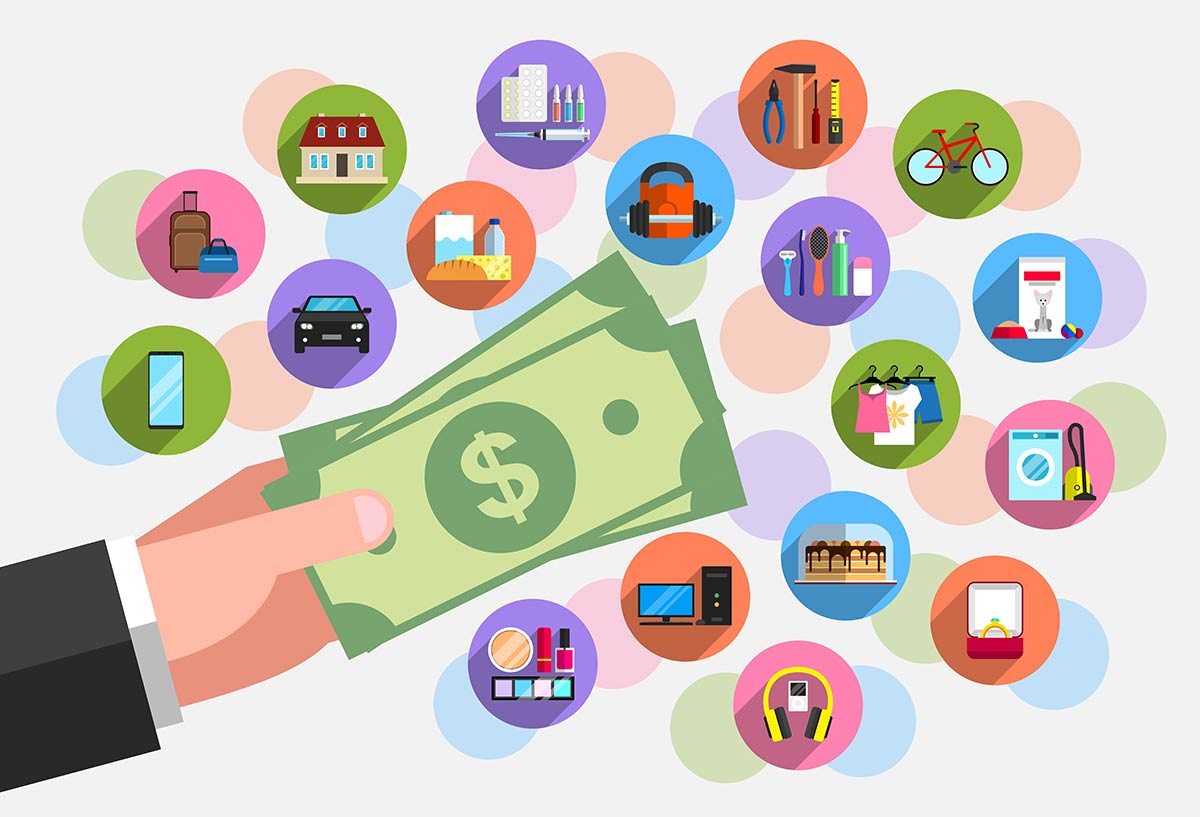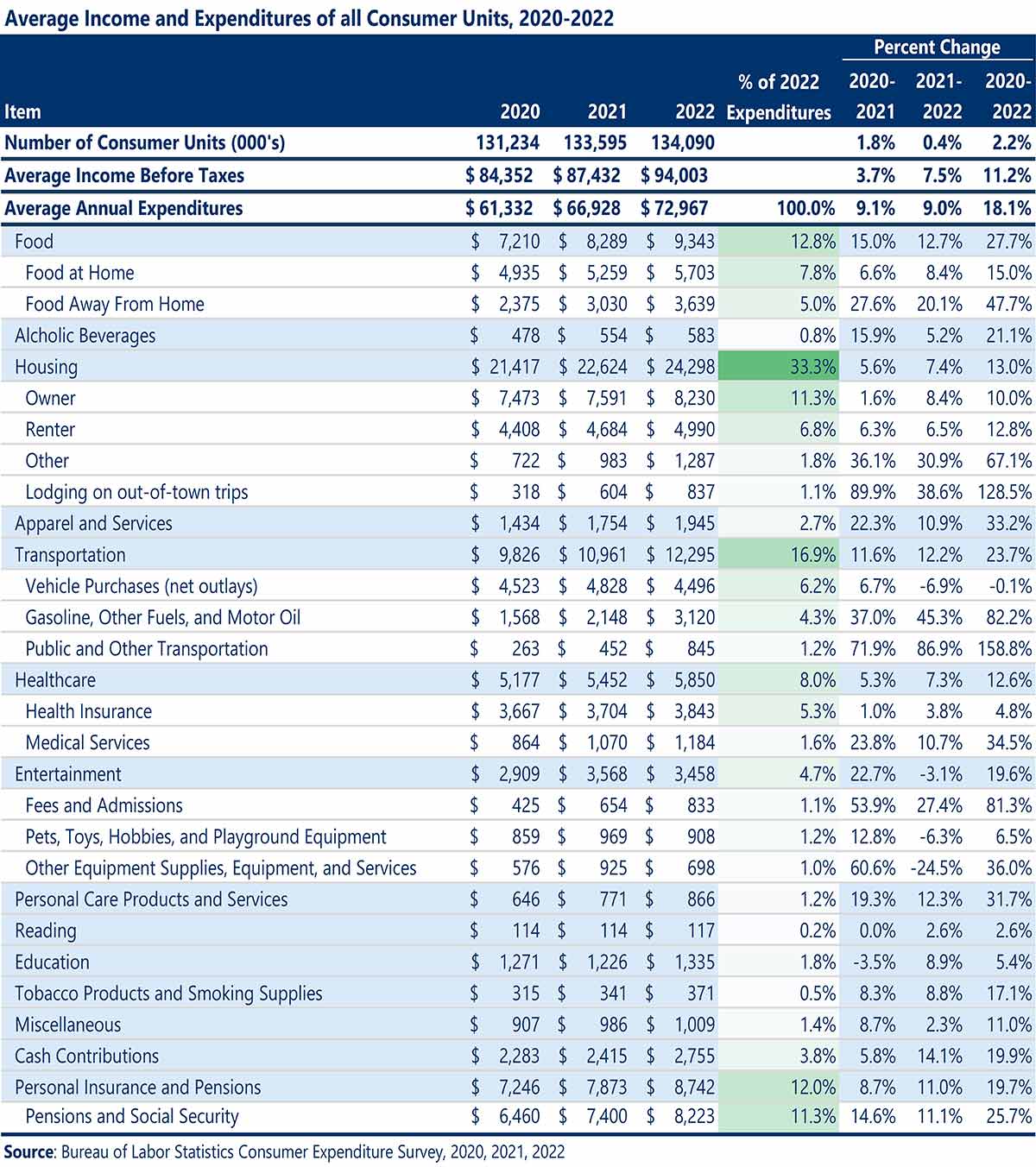- Navigator
- Economic and Fiscal Impact Analysis
- Retail, Services, and Accommodations
 The US Bureau of Labor Statistics (BLS) released the 2022 Consumer Expenditure Survey findings in September last year. The survey provided critical data about consumer spending trends and how much households spend on specific items (e.g., food, clothing, healthcare, education, housing, etc.).
The US Bureau of Labor Statistics (BLS) released the 2022 Consumer Expenditure Survey findings in September last year. The survey provided critical data about consumer spending trends and how much households spend on specific items (e.g., food, clothing, healthcare, education, housing, etc.).
The data provided in the survey is essential for impact analysis as it informs the basis for understanding household spending patterns, changes in consumer preferences, and their cascading effects on various sectors. The table below provides an overview of income and expenditures.
In 2022, the total average annual expenditures for consumer units were $72,967, an increase of 9% from 2021 and 18.1% from 2020. In comparison, the average income before taxes was $94,003, a 7.5% increase from 2021 and an 11.2% increase from 2020, indicating expenditures increased faster than income.
Focusing on the individual expenditure groups, housing, unsurprisingly, represents the largest share of consumer expenditures at 33.3% in 2022, an increase of 7.4% since 2021. This increase was most significantly driven by lodging costs, suggesting increased travel activities and hotel costs during this period.
Transportation expenses represented the next largest share at 16.9%, having risen 12.2% since 2021. Higher fuel prices and increased use of public transit can potentially explain this increase in spending. Interestingly, vehicle purchase spending decreased by 6.9%, reversing the trend from 2020-2021. Food expenses represented 12.8% of expenses and grew by 12.7%, with an apparent increase in dining out (food away from home expenditures), signaling a return to pre-pandemic habits and increased associated costs.
Apparel and services spending increased by 10.9% from 2021, a total increase of 33.2% since 2020. There has been a notable increase in footwear spending within the category, highlighting changing consumer priorities and a return to social activities.
Personal care products and services also saw significant growth, continuing the trend from 2021 and underscoring an ongoing focus on health and wellness. Personal insurance and pension expenditures also rose, driven by higher pensions and Social Security contributions.
While most categories increased, entertainment spending declined by 3.1%, indicating a shift in leisure preferences or budget allocations.
Overall, the changes in spending baskets in 2022 can be attributed to several factors beyond the raw data, including:
- Evolving consumer preferences
- Shifts in societal norms
- Technological advancements
- Changes in the global economy
- Reactions to the pandemic
What is Causing These Shifts in Consumer Spending?
- Evolving Consumer Preferences: Consumer priorities have shifted towards more sustainable and ethical products. This change is reflected in the increased spending in sectors like personal care, which can include eco-friendly and ethically sourced products. Additionally, the rise in apparel spending might indicate a preference for quality and durability over cheaper, disposable options.
- Shifts in Societal Norms: The significant increase in cash contributions, including gifts and charitable donations, suggests a shift in societal values towards more altruistic behavior. This could be influenced by a heightened awareness of social issues or an increased desire to support friends and family financially during uncertain times.
- Technological Advancements: Technology continues to shape consumer spending, with more people shopping online, which can affect individual expenditure categories differently. For instance, it might explain the decline in entertainment spending if consumers opt for digital subscriptions and home entertainment over traditional out-of-home leisure activities.
- Changes in the Global Economy: The global economic landscape, influenced by supply chain disruptions and fluctuating commodity prices, has impacted consumer spending. For example, the rise in transportation and food costs can be linked to higher fuel prices and ongoing supply chain challenges.
- Reactions to the Pandemic: As the world has adapted to the post-pandemic environment, consumer behaviors have been shifting back towards pre-pandemic norms, evidenced by increases in consumer spending on dining out and other social activities. However, the pandemic has also left a lasting impact on how individuals allocate their spending, with health and wellness continuing to be a significant focus, which is supported by the growth in spending on personal care products and services.
Understanding these underlying factors provides a more nuanced picture of why American consumers’ spending habits changed in 2022. These shifts reflect a complex interplay between individual choices, societal trends, and global economic conditions, all of which contribute to the dynamic nature of the consumer economy.
Interested in learning more about the impact of new household spending resulting from a new residential development? Camoin Associates’ Impact Analysis Team can help. Renowned for our expertise and comprehensive approach, we collaborate closely with our clients to precisely frame the issue and tailor a methodology that aligns with the target audience, ultimate objectives, and industry best practices. Understanding that numbers can be daunting, we simplify our sophisticated, technical analyses into easily understandable formats such as infographics and dashboards.
Learn more about our Impact Analysis Services
📍 Related Articles:




